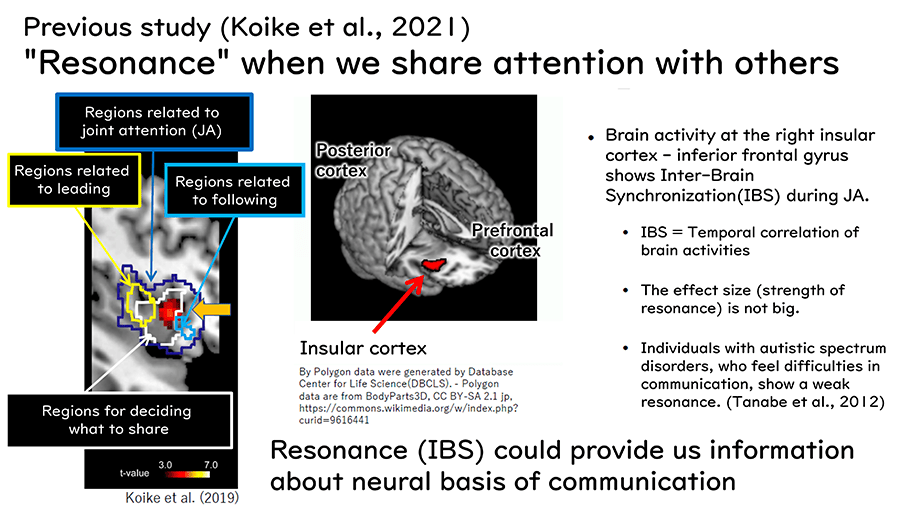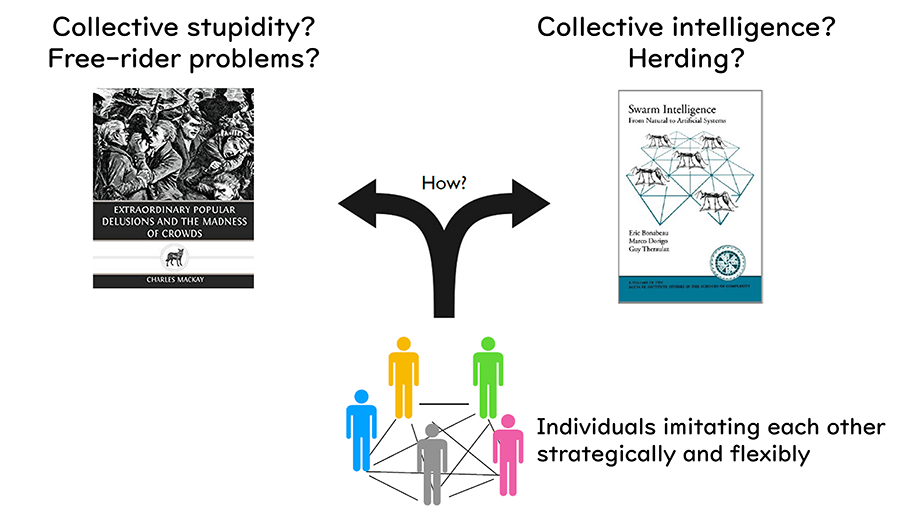Dec. 13, 2023
Why Is Toyota Conducting Brain Research: volume 3Research targets spoken about in public symposium
The Frontier Research Center of Toyota Motor Corporation (hereafter, Toyota) is exploring the possibilities created by integrating brain science and engineering: the aim is to generate innovation for the future society. As a part of that process, in 2007, Toyota established an organization for comprehensive collaboration, the RIKEN CBS-TOYOTA Collaboration Center (BTCC), with the RIKEN Center for Brain Science (RIKEN CBS) in Wako, Saitama Prefecture. Since then, they have been conducting joint brain research. In the fifth phase of the BTCC, which began in April 2023, we aim to build a mechanism and design theory for synergistic development of individual and collective well-being.
At a public symposium held on June 7, 2023, the three leaders of every BTCC unit presented their research outlook on the aims of their research from April 2023 to March 2026. Based on the symposium, We spoke with the three unit leaders about the highlights of each unit's research.
- Dr. Takahiko Koike, Inter-Individual Brain Dynamics Collaboration Unit Leader, "Our minds resonate each other: The hyperscanning fMRI approach"
How are the emotions and relationships we experience processed in the brain? Dr. Koike, who joined BTCC this year 2023, investigated the resonance of two people's brain activity recorded simultaneously during communication with fMRI (functional magnetic resonance imaging), a technique to visualize brain activity through a change of blood flow. Based on the lecture, we asked further questions (Interviewer: Hitoshi Yamada, Ph.D. (Engineering), Group Manager, Toyota).
―Dr. Koike, how are you trying to reveal the neural basis of communication with others?
We are attempting to reveal the mechanism by using an advanced technique used in the social neuroscience field, known as hyperscanning. Hyperscanning is a technique to record two or more brains simultaneously during social interaction using neuroimaging devices.
―Why do you use fMRI for hyperscanning?
fMRI is a very useful tool for measuring whole brain activation at a very high spatial resolution and can record activation in deep brain areas that are relevant to emotion.
―I heard that you explore the brain-to-brain resonance between two individuals during communication.
That's right. We focused on "joint attention (JA)," which is a phenomenon of looking at or attending to the same object and knowing that they are attending to the object together. We found inter-brain synchronization specifically in the right insular cortex.
―What does inter-brain synchronization represent?
Honestly speaking, that is a really difficult question. The degree of inter-brain synchronization between the leader and follower in JA was greater when the leader of JA voluntarily selected the target, compared to other conditions. Our interpretation is that sharing an intention to select the object is the origin of inter-brain resonance.
―Interesting. How this relates to the way we resonate with others is fascinating. Furthermore, could you tell us the idea about the relationship between inter-brain resonance and well-being?
One of our previous studies found that the anterior cingulate cortex is involved in the subjective feeling of happiness, and the cingulate cortex has a tight connection with the insular cortex, which showed greater inter-brain synchronization during communication. It implies a relationship between communication, which causes inter-brain resonance, and subjective well-being. The importance of communication is mentioned in the definition of well-being by WHO. We need do further research to reveal how communication shapes our subjective well-being and its neural basis. I think hyperscanning fMRI is a promising technique to do this.
Dr. Koike's research is likely to give us new awareness of how our emotions, relationships, and well-being are shaped in our brain, from the perspective of interactive minds and brains. Humans have a nature of interacting with others. I feel that researching this nature could be a great step for understanding not only the neural basis of communication but also the basis of our sense of self.
- Dr. Wataru Toyokawa, Computational Group Dynamics Collaboration Unit Leader, "Theoretical and empirical approaches to collective intelligence"
Dr. Toyokawa has also joined BTCC this year. Dr. Toyokawa's research focuses on how the choices we make affect the performance of society as a whole from the perspective of social science. It is also an attempt to understand how this affects the well-being of each individual and society as a whole. We interviewed him further about his research (Interviewer: Yuhei Yamaguchi, Ph.D. (Engineering), Project Manager, Toyota).
―Can you tell us about the key points of your research, Dr. Toyokawa?
Our societies and cultures have been built upon the aggregation of decision making made by each human individual, often mixing independent judgments with information transfers through social interactions. The aggregation of individual judgment can sometimes improve the performance of decision making at the group-level, which is called collective intelligence, but can sometimes hamper better decisions due to informational cascading or suboptimal herding. These two phenomena could be just different sides of the same coin, and we have experienced both sides throughout human history. In my lab, we are trying to identify mechanisms behind how collective intelligence and collective stupidity occur, and to understand dynamics of collective human behavior.
―In your research method, you first incorporate individual decision making into a mathematical model, then simulate what kind of collective behavior will result in when these individuals get together, and verify the results in a large-scale experiment.
That's right. Studying decision making using a mathematical model may seem abstract, far from the real world. However, through this modeling, the interwoven relationship between collective intelligence and herding can be disentangled, identifying key mechanisms underlying both phenomena. In the symposium, I introduced a characteristic of group dynamics that would have been difficult to understand without such modeling: even when individuals make low-risk choices, collectively they make progressively riskier choices.
―I find your research very interesting because it explains the characteristics and trends of the choices we make in our daily lives and the way our society operates. As you mentioned as an example in your lecture, the everyday question of "How should I use word-of-mouth ratings when deciding on a ramen restaurant?" made me realize once again that it is important to find a balance between "thinking for oneself and trying it out" and "imitating someone else."
If there is a good balance between the two, we as individuals will be able to eat good ramen, and society will gradually increase the number of good ramen restaurants (laughs).
―It will be very interesting to see how the vast amount of information obtained from social networking services and the rapidly evolving AI technology will affect the decision-making process of individuals to experience well-being, and how this will lead to the well-being of the group (society).
I believe that clarifying such influences and connections will lead to methods to understand our current society and to achieve a better society. I hope that when people in the future look back at us today, they will say, "How did you manage to create such a good society just with the technology that was available at that time, and how is it connected to us today?"
- Dr. Rei Akaishi, Social Value Decision Making Collaboration Unit Leader, "Depth and breadth of happiness: Multiscale approach to study Well-being"
At BTCC we have been working with Dr. Akaishi, who studies the diverse factors involved in our sense of well-being, for four years starting in 2018. Dr. Akaishi's "multiscale approach to study well-being" examines well-being from a broad perspective, from individual feelings to group culture, and to the influence of technology. We interviewed Dr. Akaishi for this interesting discussion that spans brain science, psychology, social science, and cutting-edge technology (Interviewer: Takahiro Yamaguchi, Ph.D. (Science), Researcher, Toyota Central R&D Labs., Inc.).
―Dr. Akaishi, you have a "multiscale approach to study well-being."
I believe that the happiness of the individual and the happiness of society as a whole are inseparable. I believe that brain science, psychology, and people's behavior in society and culture―all three influence each other. In addition, technologies such as artificial intelligence and social networking have a significant impact on these three, so they must also be considered together.
―What specific research are you conducting?
We investigated the relationship between "relational mobility," in which people are free to choose the group to which they belong, and loneliness. Conventionally, it is said that income and number of friends are related to loneliness, but our research has shown that high relational mobility reduces loneliness. We also found that even with high income and a large number of friends, people feel loneliness when relational mobility is low.
―So there's a connection between group culture and individual well-being.
In some cases, individual behavior can be seen to affect the group. For example, in experiments conducted through games, as the number of people in the group increased (up to five), cooperative choices increased and the repulsion of others' egocentric behavior decreased. This is presumably because as the number of people increases, it becomes easier to forget the past behavior of others and they tend to be more tolerant. In other words, it can be said that an intrinsically permissive strategy embedded in brain function attempts to create cooperative groups.
―It is interesting that in larger groups it is easier to cooperate. So how does technology affect people's well-being?
A study of the relationship between smartphone use and people's well-being and loneliness found that smartphone-only conversations do not affect well-being and loneliness, but rather the presence or absence of face-to-face communication in addition to smartphones affects well-being and loneliness. Artificial intelligence is very important and already exists in society in a hybrid state together with humans. However, at present, most research is focused on anthropomorphizing large-scale language model (LLM) and examining how LLM is characterized compared to people. We intend to study how LLM changes and impacts human culture in the future.
―We are excited about your future research. Thank you very much for your interesting talk today.
Contact Information (about this article)
- Frontier Research Center
- frc_pr@mail.toyota.co.jp













